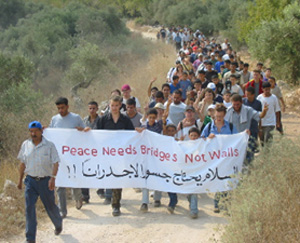|
Fighting Israel's Wall of ShameIsraelis, Palestinians and
|
 |
|
The media focuses on suicide bombers, but the vast majority of Palestinian protests of the Israel occupation are non-violent. |
TULKARM, WEST BANK -- As it snakes across the fields and over the hills of the occupied West Bank, it is initially reminiscent of the artist Christo's famous "Running Fence" which graced the hills of Northern California briefly in 1974. But this fence bristles with razor wire and electronic sensors, and is flanked by access roads and trenches.
In some places the fence becomes a reinforced concrete wall 25-feet high, interspersed with guard towers and resembles a maximum-security prison wall.
Israel calls it the "Security Fence" and claims that it is designed to prevent Palestinian "terrorists" from carrying out attacks in Israel. If this were its only purpose, then one might logically ask why doesn't it follow the Green Line, the de facto border between the West Bank and Israel?
Instead, the "Apartheid Wall," as opponents have tagged it, loops deeply into Palestinian territory, capturing valuable farmland and water resources, isolating town and cities, cutting some villages in half and leaving others stranded on the "Israeli" side.
According to the Palestinian Environmental NGOs Network (PENGON), the Wall will capture approximately 58 percent of the West Bank, leaving the majority of the Palestinian population stranded in the central highland areas. The remaining Palestinian entity will be economically unviable as a state.
Many people will be forced to emigrate. For this reason opponents say the barrier is a tool for low-key ethnic cleansing. Unless it is removed, the so-called Road Map to peace is nothing but a cruel hoax.
The first 116 km. of the Wall have been completed. The city of Qalqilya is completely surrounded by the Wall and the Israeli army controls its sole access point. The city is now a virtual prison and is dying a slow death as shops close and residents move away. Farmers in the nearby villages of Jayous and Qafin will lose about 70 percent of their land to the Wall.
In Deir el-Guson, north of Tulkarm, farmer Jalal Abdel Aziz says ruefully, "The olive harvest should begin in two months. But we have been unable to tend to our trees all summer."
But there are some signs of hope. PENGON, the Apartheid Wall Campaign, local Wall Committees and other Palestinian organizations have worked diligently to build opposition to the Wall.
The international media has finally "discovered" the Wall. Palestinian President Yasser Arafat has denounced the Wall as an "act of racism," and Prime Minister Abu Mazen insists that the Wall must be a central issue in peace talks. Even President Bush has said that he has a "problem" with a wall "snaking" through the West Bank.
Part of the credit for this shift also can go to the International Solidarity Movement (ISM). Founded two years ago by Palestinians who wished to introduce a model of non-violent direct action in support of Palestinian freedom, the ISM has since mobilized thousands of local and international activists against the Israeli military occupation.
Rachel Corrie, a 23-year-old ISM member from the U.S., was trying to prevent the destruction of a house in Rafah last March when she was crushed to death by an Israeli military bulldozer.
This summer ISM organized a major campaign against the Wall. After numerous meetings with Palestinian groups, it launched a rolling series of high-profile actions against the Wall in the northwest section of the West Bank.
The actions began on July 28 when 300 Palestinians, Israeli activists and ISMers organized a symbolic attack on the Wall in Anin village. They broke open a gate and cut a section the fence while under attack by tear gas and sound bombs. Israeli soldiers shot five people with rubber bullets. The incident received extensive media coverage and President Bush said that he would raise concerns about the Wall in a meeting with Israeli Prime Minister Ariel Sharon the following day.
On July 31, ISMers and Palestinians released balloons and spray-painted slogans on the towering gray Wall around Qalqilya. The next day 500 Palestinians and ISMers mounted another protest at the Wall near Tulkarm. On August 6 the Bush administration threatened to withhold billions of dollars of loan guarantees if Israel persists in constructing the Wall.
ISM's summer campaign is now winding up, but PENGON and other Palestinian organizations have planned monthly actions through the rest of the year.
Neal Cassidy teaches at the American International School of Rotterdam, The Netherlands and did the photography for From Stones to Statehood: The Palestinian Uprising.
| Month in Review |
|---|
|
August 2010: |
| PAST articles |
Detoit: I Do Mind Empire (USSF Recap) “Bring the War (English) Time for Rebirth: (English) War Weariness, Military Heft, and (English) The Global Military Industrial Complex (English) A Stalled (English) Bush's Iraq “Surge”: Mission Accomplished? Iran: Let's Start with Some Facts Nuclear Weapons Forever (English) Time to End the Occupation of Iraq First-Hand Report from the Middle East (English) Haditha is Arabic (English) A Movement to End Militarism From Soldier to Students Not Soldiers Israel's "Disengagement" U.S. Soldiers Torture: Help Stop Torture — Be All You Can Be: OCTOBER 2006
|
|
War Times/Tiempo de Guerras is a fiscally sponsored project of the |